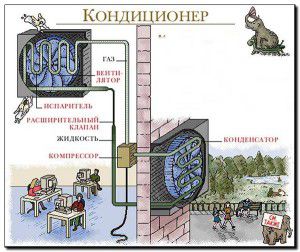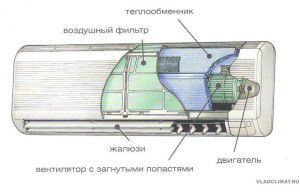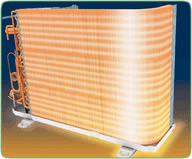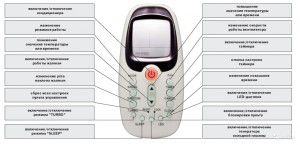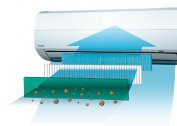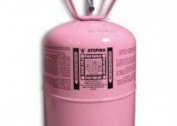The principle of operation of the air conditioner for heating
Most modern split systems can not only cool, but also warm. What is the principle of operation of the air conditioner for heat, and is it different from the cooling process?
The basis of any refrigeration unit operating on freon is the principle of the phase transition of liquids at different pressures and temperatures, that is, the ability of freon to evaporate and condense under appropriate conditions.
When the phase transition temperature is lower than the environmental indicators, the refrigerant turns into vapor - it just boils and takes heat from the air. If the phase transition temperature is higher than the temperature values of air, then freon is converted into gas, at which it gives off heat back to the environment. The interaction with air goes through heat exchangers - an evaporator on the indoor unit and a condenser on the outdoor.
In all these processes, the necessary pressure must be created, since in ordinary atmospheric neither evaporation nor condensation will occur. Two devices included in the refrigeration circuit provide the required indicators - a compressor and expansion valves for semi-industrial / industrial systems or a capillary tube for domestic ones. The first increases the pressure for condensation, and the second lowers it for evaporation.
“Warm” or “reversible” air conditioners have no special differences in principle of operation from “cold” ones. Their main feature is the presence of a four-way valve, which is responsible for changing the heat exchangers in places. In this case, the condenser coil becomes evaporative and vice versa, that is, the outdoor module takes heat from the street, and the internal one delivers it to the room. This valve redirects freon in the opposite direction.
Using the air conditioner in heating mode in winter
Speaking about the principle of the air conditioner working on heat, one can involuntarily think about how the heating process occurs at autumn-winter temperatures on the street. Is it even possible to bask with this appliance?
The bulk of split systems cannot be switched on in frosts below -5 ° C; in inverters, these figures reach -10 °. It is because of a decrease in efficiency, which under normal conditions reaches almost 300%, the operation of the air conditioner in the winter for heat becomes unprofitable. The temperature difference between the outdoor air and the heat exchanger of the outdoor unit must be at least 4-5 ° C. In frost, this principle is violated, and heat recovery becomes problematic.
Another reason why a conventional air conditioner cannot be turned on in winter for heat is the occurrence of technical problems in the system due to:
- oversized capacitor of the external unit;
- thickening oil in the compressor crankcase;
- condensate freezing in the drainage hose;
- leakage into the freon crankcase in a liquid state during cold start.
It turns out that the operation of the air conditioner in winter for heat brings more problems than benefits. An exception may be the split systems of some Japanese brands, which equip their chillers with integrated drain hose and crankcase heaters, and also use two-phase freon injection technology and compressors with an injection fitting. Such units are also heated at -25 ° C.
There are winter kits for split systems, consisting of heating the drainage, a fan retarder and heating the compressor crankcase.Many are mistaken, considering that with them you can turn on the air conditioner in the winter to heat even at -20 ° C.
A split system equipped with a low-temperature kit may only be used in cold weather for cooling!
When buying, be sure to pay attention to the limitations of the operation of the air conditioner for heat / cold, since not all models are able to maintain the necessary temperature parameters in a particular region. Standard heating temperature limits at the lower limit of normal are up to -5 ° C.
What other operational features of the air conditioner exist when working on heat? It is worth considering that the upper limit of the norm also exists. Most of the on-off split-systems of the household class are configured to heat the room from + 18-20 ° C. If it is necessary to expand these borders, they select a model designed for the northern regions and countries.
How to turn on the air conditioner for heat
Most users do not know the basic rules for using a refrigeration device. For example, on the Internet, you can often find the question: “How to turn on the warm air on the air conditioner or how to put it on the heat?”.
Using the remote control
Let's figure it out. If there are no instructions on hand for the device, then operate according to the following scheme:
- turn on the air conditioner by pressing ON / OFF;
- on the panel of the remote control they find the MODE or HEAT button (for some air conditioners it is hidden under the panel, which can be moved away with a touch of your fingers);
- they click on it and wait for the "sun" icon or the inscription "HEAT" to appear;
- select the required temperature with the “triangle” icon, which is responsible for the temperature parameters (these can be the “+” and “-” buttons);
- some air conditioners require an additional press of the ON button to start the program.
Usually, when you turn on warm air on the air conditioner, all processes are accompanied by sound signals. You will have to wait a few minutes, since the device does not start to heat immediately - first it takes time for the fan to work.
If there is no MODE button, how to set the air conditioner to heat in another way? Some remote controls have a designation of the main modes in the form of icons "snowflake", "droplet", "sun" and so on. In this case:
- choose the "sun" and press;
- waiting for the display of the icon on the screen;
- then set the temperature;
- start the mode with the ON button (if this model is required).
It is worth remembering that the presence of HEAT buttons or the “sun” icon does not mean that it is possible to put the air conditioner in thermal mode. Many manufacturers complete the remote controls with a standard set of buttons, regardless of whether it is “reversible” or “cold”.
What to do if you need to switch the air conditioner to heat from another mode? All actions are in accordance with the previous instructions. It will take a little more time for the system to be rebuilt from one mode to another - on average 5-7 minutes. Thus, the room is protected from cold air from the street.
From the front panel of the indoor unit
If the remote control is lost, how can I turn on the warm air on the air conditioner using the front panel on the indoor unit? Such a function is not provided in this case, since this regulation method is intended for emergency situations. He is responsible for switching in the following sequence:
- auto mode;
- cooling;
- shutdown.
Switching to heat will only happen in automatic mode, if the sensors show that the programmed temperature does not match the required values. It is impossible to increase or decrease its performance from the front panel.
Possible malfunctions and solutions
Heating mode does not turn on
Often users are faced with the fact that the air conditioner does not work on heat even after an acceptable period of time.What is the reason for this? There are several reasons why the air conditioner does not turn on the heat:
- The air filter system can be heavily contaminated with fluff, dust and debris. You will need to clean all its elements;
- Sometimes a power failure occurs on the remote control. It is necessary to remove the batteries for 5 minutes or replace them with new ones, and then try to start the device again;
- If before that there was a failure in the power supply, you can disconnect the split system, and after an hour run again, setting the maximum heating temperature;
- Failures occur in the control system of the indoor unit, then the light indicators on the panel indicate this and the error code mode goes off;
- Perhaps the operation of the air conditioner for heat is made in unacceptable temperature conditions in the outdoor air. Many modern chillers are equipped with protective algorithms that slow down compressor startup in such situations. We can say that this is “protection from the fool”;
- It is likely that the air conditioner does not turn on for heat due to inappropriate pressure standards. It is worth checking its "liquid" and "solid" indicators.
Why sometimes the air conditioner turns on for heat, and then abruptly stops blowing, and the curtain on the indoor unit closes? If the diodes go out at the same time, and after restarting the same thing happens, then the device is faulty. You must call the wizard.
Noise at work
There is also such a problem as the hum of the air conditioner when working on heat. Where to find the reason?
- This may be the norm. Some models work quite noisily;
- If the hum is monotonous, then the reason may be in the compressor, which simply can not cope with the load, or the evaporator as a condenser does not pull the heat load. Pressure may be exceeded. It is worth checking whether the volume of freon meets the permissible values;
- Another option why the air conditioner is buzzing when working on heat is the pollution of the filters and the fan of the indoor unit. The device cannot take a normal volume of air;
- There is a possibility that the fan is damaged and clings to something;
- It is worth checking the freon highway, since its poor-quality installation causes similar problems. Somewhere there may be creases and bends;
- It is possible that the air conditioner when working on heat starts to buzz due to insufficient voltage in the network;
- For stopping and starting the fan motor at the external module, the evaporator temperature sensor (on the gun) is responsible. It may be malfunctioning.
The main reasons why air conditioners do not turn on the heat or buzz when heated are considered.
Blows warm air instead of cold
Now another question arises, why does the air conditioner blow with warm air when cooling is required? There are many reasons, so you should understand:
- Check if the mode is set correctly;
- Look at the degree of contamination of the grilles and filters. Air does not pass, so Freon does not cool;
- There may be problems with the voltage in the network (it is simply not enough), or the integrity of the interconnect wires is violated;
- Poor installation: the lack of evacuation, tightness checks and insufficient filling of the circuit with freon can provoke such problems;
- If the capillary tube is clogged with debris, it can blow warm air from the air conditioner;
- Faults in the pressure and temperature sensors, the compressor, or fans are also manifested by similar operating features.
In addition to these reasons why the air conditioner blows hot air in cooling mode, there are others that cannot be determined without the help of a wizard. Any malfunction should be fixed only with the help of climate specialists!
